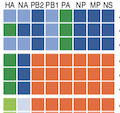Abstract
Global swine populations infected with influenza A viruses pose a persistent pandemic risk. With the exception of a few countries, our understanding of the genetic diversity of swine influenza viruses is limited, hampering control measures and pandemic risk assessment. Here we report the genomic characteristics and evolutionary history of influenza A viruses isolated in Australia during 2012–2016 from two geographically isolated swine populations in the states of Queensland and Western Australia. Phylogenetic analysis with an expansive human and swine influenza virus dataset comprising >40,000 sequences sampled globally, revealed evidence of the pervasive introduction and long-term establishment of gene segments derived from several human influenza viruses of past seasons, including H1N1/1977, H1N1/1995, H3N2/1968, H3N2/2003, and H1N1pdm09, and a genotype that contained gene segments derived from the past three pandemics (1968, re-emerged 1977 and 2009). Of the six human-derived gene lineages only one comprising two viruses isolated in Queensland during 2012 was closely related to swine viruses detected from other regions, indicating a previously undetected circulation of Australian swine lineages for approximately 3–44 years. Although the date of introduction of these lineages into Australian swine populations could not be accurately ascertained, we found evidence of sustained transmission of two lineages in swine during 2012–2016. The continued detection of human-origin influenza virus lineages in swine over several decades with little or unpredictable antigenic drift indicates that isolated swine populations can act as ‘antigenic archives’ of human influenza, raising the risk of re-emergence in humans when sufficient susceptible populations arise.
